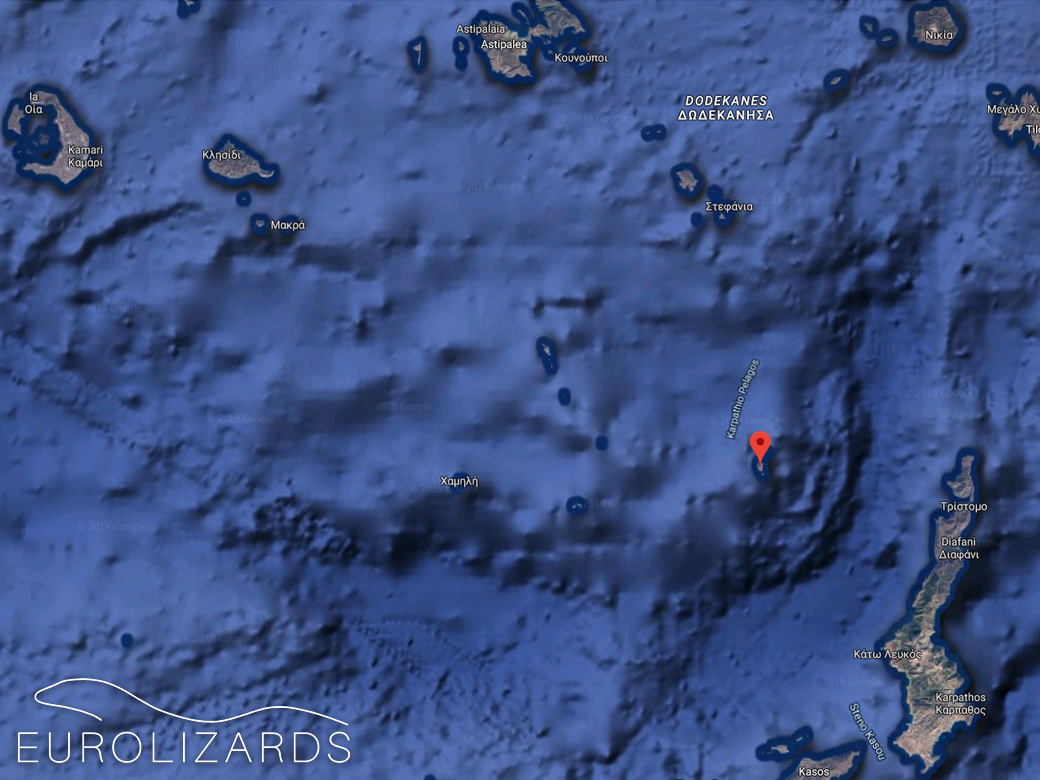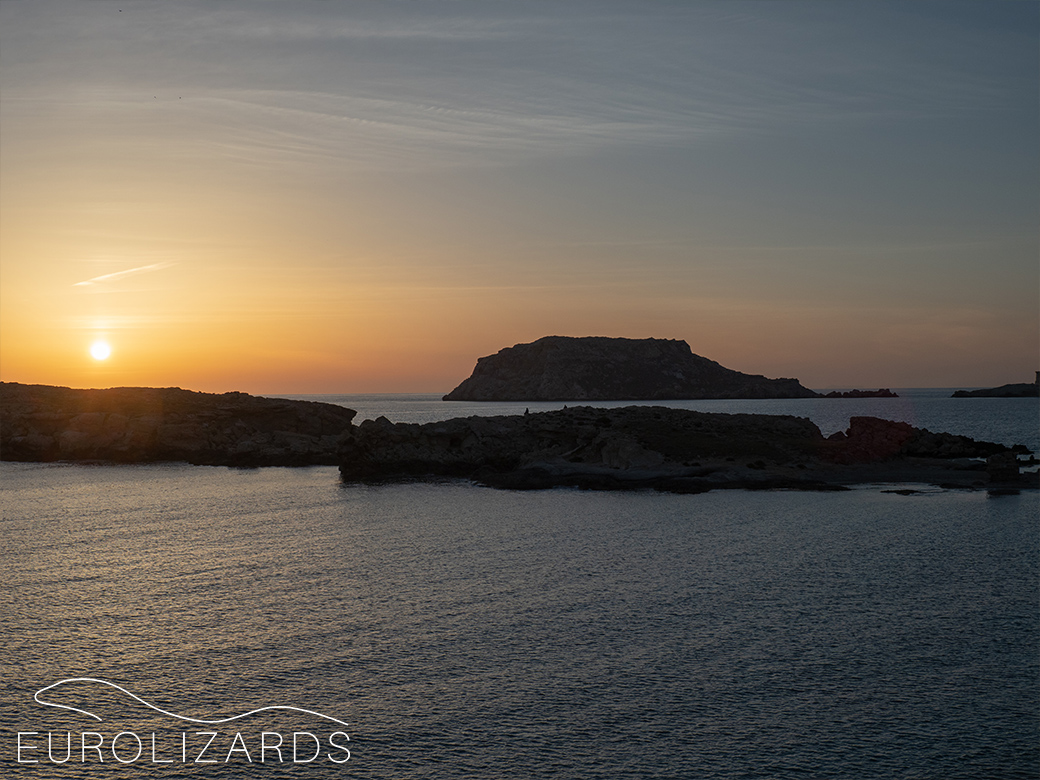Karpathos & Astakida, 26.-29.5.2019
Due to strong wind, high waves, landing difficulties and time pressure, we weren’t able to visit the […] Stakida cluster, which, as far as I know, has never been visited by a scientist. It was the most tragic moment of our otherwise successful Aegean Sea expedition, when on 27th of May 1935 we had to turn back, being in sight of these islands, knowing that we probably would have never again the chance for a visit.
OTTO WETTSTEIN, Herpetologia aegaea, 1953, p. 727 (free translation)

In 1935, Austrian Herpetologist OTTO WETTSTEIN intensively explored the populations of Podarcis erhardii (Erhard’s Wall Lizard) on numerous Aegean islands – however, he failed to visit some of the extremely isolated south-eastern Aegean Islets including the Astakida cluster. Since then, very few scientists have visited this place and there were no publicly available pictures of the local Wall Lizards. 84 years later, during the annual meeting of the Austrian Herpetological Society in Vienna (January 2019), we met Johannes Foufopoulos (University of Michigan) and the idea for a joint trip to Astakida island was born. Visiting this remote island would be a dream come true!
However, the Carpathian Sea is known as an extremely windy area – a boat trip can easily be spoiled by high waves (see Wettstein’s experience). Therefore, a powerful boat was required and we had to be quite flexible and wait for calm weather conditions. In the evening of Friday, 24.5., I (Peter) finally received a message from Johannes, that there should be a window for good weather on Tuesday (28.5.). Being busy at work, I actually had no time for holiday. However, I desperately wanted to join this trip. Finally, I had at least 3 days for this journey. I booked a flight to Karpathos where I arrived on Sunday evening (26.5.). (Birgit, unfortunately wasn’t able to join this time.)

Karpathos (27.5.)
Monday morning, I picked up Johannes at Karpathos airport. He had perfectly pre-arranged everything and we first met the guys from the National Park Authority. Afterwards, we met our excellent skipper to plan our Astakida trip. In the afternoon, we still had a little time for herping. Of course, late May was the wrong season for the Karpathos Salamander (Lyciasalamandra helverseni) but at least we found the Karpathos Water Frog (which is considered now as conspecific with Levant Water Frog / Pelophylax bedriagae) including some tadpoles as well as Mediodactylus oertzeni (Oertzen’s Gecko). Caspian Whipsnake (Dolichophis caspius) was only seen DOR.
Karpathos is a wild island with an impressive, steep mountain scape. In particular in the northern part, the windswept pine forests attest to the extreme climate in that area. Although it seems to be Lacertid-free, it really would have been worth to spend more time on this island.
Astakida (28.5.)
Tuesday morning, as predicted, the weather was fine. We met our skipper, who brought us to the Astakida Cluster (Astakidonisia), a group of four uninhabited islets, and we were able to visit all of them. The main islet, Astakida, covers about one square kilometer and it is located about 30 kilometers west of Karpathos. The Astakidonisia mark the south-easternmost point of several highly isolated and uninhabited islets in the southern Aegean area. Surrounded be deep water, they have never been connected with mainland or with any bigger island in the Aegean. Being located at the very edge of the Aegean plate, the Astakidonisia are somehow “the last of the last” islands: They are separated from Karpathos by the Mid Aegean Trench with water depths of more than 2000 meters. In consequence, the Karpathos fauna is highly influenced by Asia Minor whereas the Astakidonisia are “European” islands.
Astakida as well as the smaller Astakidópoulo islet have remarkable populations of Erhard’s Wall Lizard: Like on other eastern Aegean islands, these lizards are rather short-legged, ground-dwelling and pretty shy. Males show dark colours on their backs and dark blotches on the throats (although they are not melanistic). Their eyes appear smaller than in other Podarcis erhardii populations, which might be caused by rather big scales on the eyelids – maybe an adaption to dry and windy weather conditions. On both islets the lizards occur in good numbers. However, photographing these lizards was quite challenging (I experienced a similar situation during my visits on Pachia and Pergousa – see our 2018 Nisyros trip report). But with some patience, I succeeded to take some pictures. Mission accomplished!
The only other reptile species on the Astakida cluster seems to be Mediodactylus oertzeni which we encountered on Astakida and the smaller Sial islet (It probably also occurs on Astakidópoulo). According to KOTSAKIOZI et al. (2018), the geckos of the small eastern Aegean islets seem to refer to the same species as those on Rhodos and Karpathos (Mediodactylus oertzeni). However, these small islet populations look quite different. The specimen from Astakidonisia resemble to what has been described as subsp. stepaneki by WETTSTEIN (1937) for the neighbouring islets of “Megali Zafrana”, “Tria Nisia”, “Goat Island” and “Due Alphaes”: "A small subspecies with conspicuous longitudinal stripes, no prominent rows of tubercles..." (p. 79, free translation). Possibly, this morphe should be interpreted as a small island ecotype.
The smallest islet, Nimo, is only vegetated by halophytes and the limestone rocks are strongly eroded by salt water – possibly there are no reptiles on this islet.
On our way back we had a very short stop-over on Saria island north of Karpathos. But as we were running out of time, no more herptiles were found.
Unfortunately, I had to take a flight back to Germany the next morning. Anyhow, this was a very short but highly impressive trip. Many thanks to Johannes for his perfect preparation and excellent company – hope to meet you again in the Aegean!
Preliminary notes on pair behavior of Podarcis erhardii
During our trip to Serifos in 2018, we noticed a strong tendency to pair behavior in Podarcis erhardii which seems to last even after mating season has ended. The same seems to apply for the Astakida lizards. Generally, these lizards are territorial, although intraspecific aggression seems to be moderate. The picture sequence below shows the pair behavior of these lizards. The female was already pregnant and therefore not willing to mating. Anyhow, the male tried to bite the female’s tail, but rather unobtrusively, almost “tenderly”. The female refused the male’s approach, but not too aggressively. Remarkably, “smelling” appears to play an important role. Both partners were observed sniffing at the hindlegs of each other and afterwards, flicking their tongues. They subsequently were observed creeping slowly on the dry branches of Euphorbia dendroides with sprawled tails, rubbing the underside of their hind legs on the branches – a behavior which resembles to cats marking their territories. Possibly, the pheromones of the femoral pores play a crucial role in pair behavior of Podarcis erhardii.
Literature:
KOTSAKIOZI, P.; JABLONSKI, D.; ILGAZ, Ç.; KUMLUTAS, Y.; AVCI, A.; MEIRI, S.; ITESCU, Y.; KUKUSHIN, O.; GVOZDIK, V.; SCILLITANI, G.; ROUSSOS, S.; JANDZIK, D.; KASAPIDIS, P.; LYMBERAKIS, P.; POULAKAKIS, N. (2018) - Multilocus phylogeny and coalescent species delimitation in Kotschy's gecko, Mediodactylus kotschyi - Molecular Phylogenetics and Evolution 125: 177-187
WETTSTEIN, O. von (1937) - Vierzehn neue Reptilienrassen von den südlichen Ägäischen Inseln. - Zoologischer Anzeiger, 118 (3/4): 79-90.
WETTSTEIN, O. von (1953) - Herpetologia aegaea. - Sitzungsberichte der Akademie der Wissenschaften, Mathematisch-Naturwissenschaftliche Klasse. Wien, Abteilung 1, 162 (9/10): 651-833.

EUROLIZARDS - The Home of European Lizards! © Birgit & Peter Oefinger


















































